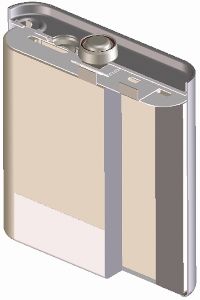Charge pattern per cell in a Li Ion is almost identical to that of a properly charged lead acid battery (which just happens to have 6 cells in it
The current goes down on its own as the charging medium saturates (thus the full point being the current flow is not 10% of the battery capacity) , the constant current is there to limit MAXIMUM charge rate, otherwise just limiting voltage charging could be easily done with a constant voltage regulator, but the amount of current the battery will absorb initially will very large, dangerously large if not limited)

BU-409: Charging Lithium-ion
BU meta description needed...


BU-403: Charging Lead Acid
BU meta description needed...

Notice the constant current dashed portion of the graph, voltages are different per cell naturally, but the constant current aspect is the charge pattern that determines the “fullness” of the battery
I use one of these to charge my daughters 6vdc lead acid battery in her little power wheels car, set to 2.35vdc per cell, then feed the output thru a HF multimeter, short the leads adjust max current rate to say 1A or less, then tie into the battery, you can watch the volts drop, current goes up…but after a while as the current draw lowers the voltage levels out at the set rate, then as the current decreases to around 10% of maximum rated mAh of the battery, then its full, nice thing is with lead acid you can set a float voltage or approx 2.25vdc per cell (13.8 for a 6 cell “12vdc lead acid battery” and leave it indefinitely as the battery no longer absorbs current at the lower voltage setting.
Apply 13.8V to any nominally 12V lead-acid battery and it will take just the current needed to keep itself in tip top condition, and it will be ready to deliver its full capacity instantly. Applying a constant potential is called ‘float charging’ and lead-acid batteries are almost perfectly suited to it.
In fact if you charge at 4.2vdc, you can “float voltage” a Li Ion cell at 4.1vdc but the Li Ion chemistry and construction is very different and complex…it’s best to just charge then remove the charge from Li Ion where lead acid can be floated indefinitely

Float charging lithium ion cells
Researchers have found a way to float charge lithium ion batteries, which opens up the number of applications
Est. reading time: 5 minutes
You can charge a 4.35vdc Li Ion cell on a 4.2vdc charger, it just won’t saturate fully, or ever maximum charge, it will be perfectly fine to use but won’t ever be at it’s full maximum mAh rating.
Manually charging a battery is possible…but it must be monitored CONSTANTLY, these Li Ion chargers the IC does the monitoring for us
They do offer Li Ion charging IC’s that charge at 4.35vdc…but you have to build the board yourself
Just ran across this Most of us can’t find TP4056 replacement chips Another solution has presented itself The MCP73833 Stand-Alone Linear Li-Ion / Li-Polymer Charge Management Controller Datasheet Saw it when I went spelunking at OSHPark for “shared projects” https://oshpark.com/shared_projects/sI7gZM2g [image] So building a small board just like the TP4056 you can get a 1A charging rate [thermally controlled] (or just buy a bucket load of those cheap Chinese TP4056 boards. Unsure if i…
Take this charger above, gut it, tie in the above linked charging module w/ a 4.35vdc MCP73834 (the MCP73833 is the 4.20fixed output chip) and it will charge those batteries at the correct CC/CV rate (also the Xtar MC1 is a good little host unit as well)
More or less this
